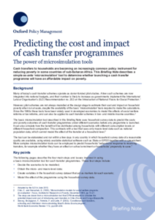Cash transfers to households are becoming an increasingly common policy instrument for reducing poverty in some countries of sub-Saharan Africa. Many of today’s cash transfer programs operate as donor-funded pilot studies which are not always modelled at the design stage to estimate their cost and impact on household poverty when run at scale. Basic ‘microsimulation’ tools, widely used in developed economies since the 1960s, are necessary in order to make the calculations needed to model the effects of social welfare reforms or tax reforms, and can also be applied to cash transfer schemes in low- and middle-income countries. This Briefing Note describes a simple ex-ante ‘microsimulation’ tool to determine whether launching a cash transfer programme will have an affordable impact on poverty.
The microsimulation tool uses household survey data to predict the costs and poverty outcomes of cash transfer programmes under different scenarios before any programme is launched. It can also simulate how the benefit will be distributed among households with different consumption levels or different household composition – something that is not possible with tools that use only macro-level data, such as national population data. Additionally, the tool can be elaborated and run within a few days in any country in which household survey data of a reasonable quality are available, using widely available statistical software.
The Briefing Note explains the key steps required to use a microsimulation tool. These include: deciding the scenarios to be modelled; obtaining the micro- and macro-level data; creating variables in the household survey dataset that act as markers for each scenario; and modelling the effect of the programme using the household survey data. According to the note, using a basic simulation tool policymakers can determine whether a cash transfer programme is likely to be an effective or affordable part of social protection. When combined with other tools such as a political economy analysis or an assessment of institutional capacity to deliver the programme, this approach can provide an even more powerful early indication of the programme’s potential success before significant resources are committed.

